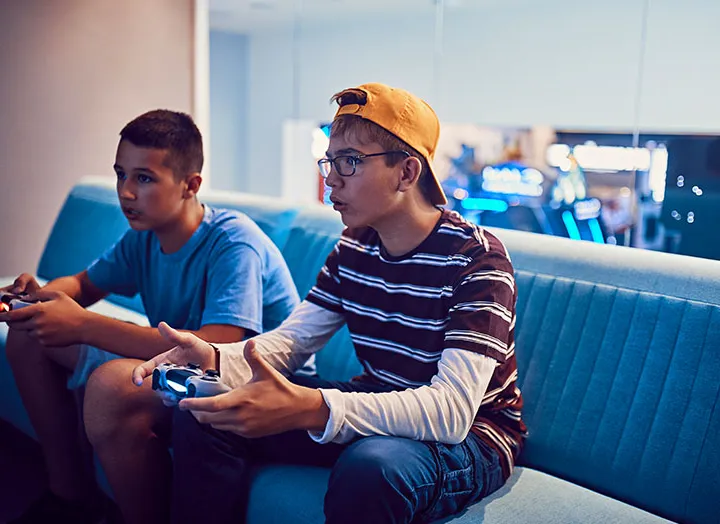Introduction
Historically, video games were often marketed more heavily toward men, particularly during the early years of the industry. However, this perception has evolved significantly in recent years. The current video game audience is diverse, with nearly equal representation of both genders.
According to various studies and reports, women now make up a substantial portion of gamers. For instance, a 2022 report from the Entertainment Software Association (ESA) found that around 48% of gamers in the U.S. are women.(TrueList)(El Mundo Tech) This data was gathered from a survey conducted by the NPD Group involving nearly 4,000 respondents. The report highlights the growing diversity in the gaming community, showing that the gender gap among gamers has narrowed significantly over the years. The range of game genres, from action-packed shooters to puzzle, simulation, and mobile games, has helped expand the audience beyond traditional demographics.

Are there any differences between the types of games that are been made for men vs women?
Yes, there are often differences in the types of games that tend to appeal to men versus women, but these distinctions are more about trends than hard-and-fast rules. Game preferences vary widely among individuals, regardless of gender. However, marketing and design strategies have historically targeted men and women differently based on perceived preferences.
Here are some general trends:
Male Targeted Games:
Action & Shooter Games: If you are looking for titles such as Call of Duty, Halo or Grand Theft Auto, chances are the games will be targeted towards male audiences. They are the games that more often than not feature combat, strategy and competition.

Sports Games (FIFA, NBA 2K, Madden NFL) — The male sports gamer; fans of real-world sports actions.

RPGs: Although girls also play those, game titles for example The Witcher and Skyrim have generally been built with a bigger viewers of men because of their complicated gameplay and story-driven action.

Games Generally For Women:
Casual and Puzzle Games: Mobile games like Candy Crush are also more popular among women, as well as games like The Sims or Animal Crossing. Games such as The Sims and Stardew Valley, in which the main goal is creativity like social interaction or life management usually attract over twice of their player base who are ladies.

Narrative Driven/ Story Rich Games: Games that have a strong narrative element and are emotionally engaging like Life is Strange or Firewatch are usually good pickings for female gamers.
Changing Trends
Mobile Games: Most mobile games are played by women, the game genre is focused on casual gaming, puzzle gaming and simulation.
Wide-ranging tastes: Women are increasingly playing video games in typically male-dominated genres such as RPG, action-adventure and even shooters
Why gaming is still seen as a boy’s club, even though women are everywhere
Research demonstrates there are differences in the types of video games marketed to men compared to women, but as the gaming industry changes, these distinctions are beginning to narrow.
Men’s Genre Interest: Men are usually attracted to competitive, results-based games i.e., action/sports/shooters. In contrast, women prefer puzzles, simulation and casual games, particularly on mobile devices (Newzoo)(Frontiers). For example, Candy Crush is the top-ever game genre for more women than it is for men), whilst strategy and shooter games are predominantly regarded as male genres (e.g. Call of Duty) (Newzoo).

In the beginning, video games were mainly aimed for men, which supported previous gender bias and leads to flawed generalisation of gamer persona. That has changed a lot in the last few years. But what’s strange still is that while women make up almost half of all gamers, they are less likely to consider themselves a “gamer” than men (Pew Research Center). Why gaming is still seen as a boy’s club, even though women are everywhere?
1. Spending Habits — Men are more likely to spend money on peripherals and in-game currency, especially when it comes to the PC, and console markets. Nonetheless, female gamers demonstrate high involvement in mobile gaming; but they also generate a substantial portion of their revenues through in-game purchases (Newzoo).

2. Stereotypes vs Reality– Although stereotypes regarding what sort of person is likely to play video games are all but inaccurate research has found that the gender divide of who is playing what kind of games has often been distorted. This includes the fact that while genres like shooters are indeed dominated by men, consumption of video games is fairly evenly split — both genders play games of all types on most platforms in similar volumes.(Frontiers).
3. Historical Market Trends– In the beginning, video games were mainly aimed at men, which supported previous gender bias and leads to flawed generalisation of the gamer persona. That has changed a lot in the last few years. But what’s stranger still is that while women make up almost half of all gamers, they are less likely to consider themselves a “gamer” than men (Pew Research Center)

In previous times, game developers used to hit all this stuff, but nowadays theres a lot of different style for games and many of them can be aimed at both male and female. Greater audience coming to ALL genres from all the many developers who are including them in their designs.
Conclusion
With the advent of this millennium, men were almost synonymous with early video games, especially as leads in first-person shooters. However, women now share an almost equal part of the gaming audience, with overlapping interests. Today, women make up nearly half of all gamers, with around 40% participating in traditionally male-dominated genres. This shift reflects a growing empowerment of female gamers. While differences in game preferences between the genders remain, this gap is rapidly closing. Developers are increasingly creating games for everyone, contributing to a more inclusive gaming community. Despite this progress, the stereotype of gaming as a “boy’s club” persists, partly because female gamers are less likely to identify as “gamers,” even though they represent half of all players. As the gaming industry continues to evolve, the hope is that these barriers will disappear, fostering a fully inclusive.
Feature Image Courtesy: PureWow





